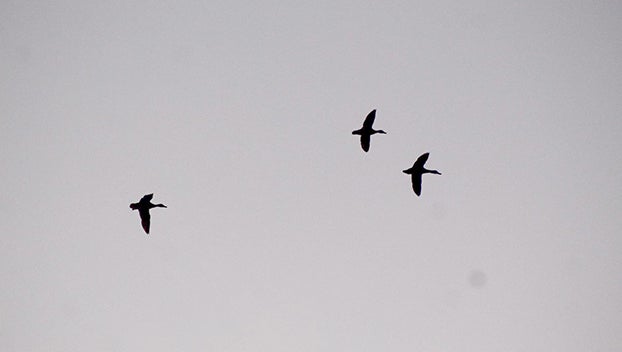Record low duck numbers in November Aerial Survey
Published 11:55 am Friday, November 24, 2023

- Three ducks fly over St. Catherine Creek National Wildlife Refuge south of Natchez. (File Photo | Hunter Cloud)
JACKSON — Mississippi has been in severe drought or exceptional drought for much of the summer and fall according to the National Drought Monitor Center in Omaha, Nebraska. Water is needed for waterfowl but migration of birds is also dependent on weather conditions north of Mississippi.
Mississippi Department of Wildlife, Fisheries and Parks Waterfowl program coordinator Houston Havens and Waterfowl biologist Darrin Hardesty took to the skies from November 13 to 16 to survey waterfowl distribution, habitat abundance and quality of wetlands prior to Mississippi’s duck season opener Friday morning. Mississippi’s first duck season split of the year is from November 24-26 with the second from December 1-3 and the third and final split is from December 9 to January 31.
The survey confirmed dry conditions were prevalent in the Mississippi delta, not uncommon for November. Dry conditions were more pronounced this year with permanent and semi-permanent bodies such as oxbow lakes and sloughs having low water levels or being completely dry.
Hardesty and Havens noted in their report that Mississippi’s public lands managed intensively for waterfowl provided water and ducks were observed responding favorably to public land.
“Ducks were also observed using areas with large complexes of managed water across multiple private properties. As a result of the dry fall, most harvested agricultural fields have been disked,” the report states. “This will result in reduced food availability for waterfowl if the fields are eventually flooded. Much opportunity remains for landowners and managers to capture rainfall with water control structures as fall and winter continue.”
Duck abundance was well below the November average. 86,035 ducks were estimated in the report and that is below the average of 252,234 ducks. The last time duck numbers were below 140,000 for November was in 2007 to 2008 season with 88,106.
Dabbling ducks and mallards made up 46 percent of duck observations with northern shovelers and mallards making up the majority of dabblers. Diving ducks were mostly made up of scaup and ring-necked ducks. Northeastern parts of the Delta had the greatest abundance of all ducks observed. Hardesty and Havens wrote the low observations are due to drought conditions and mild weather. Survey efforts in mid -latitude states showed hope for this season.
“They have recently observed above-average duck numbers, which bodes well for continued southern migration,” the report states. “Mississippi’s November duck estimates are typically not strong indicators of where peak numbers will reach later in the season.”
The report states there was no concentrations of light geese, snows, blues Ross or speckledbellied geese during the survey. Numbers are growing in the delta of these geese based on recent observations, the report states.
Let us know how the duck season opener was in your neck of the woods and email pictures to hunter.cloud@dailyleader.com.





